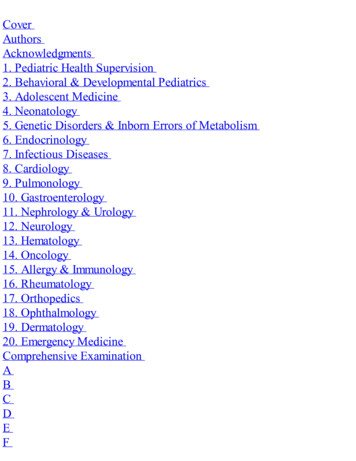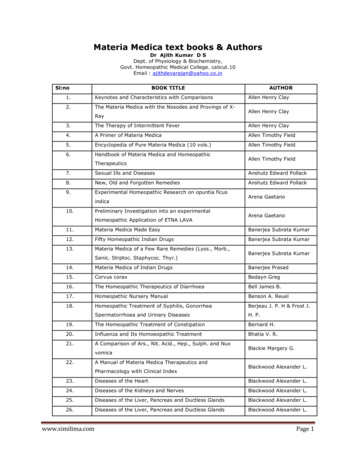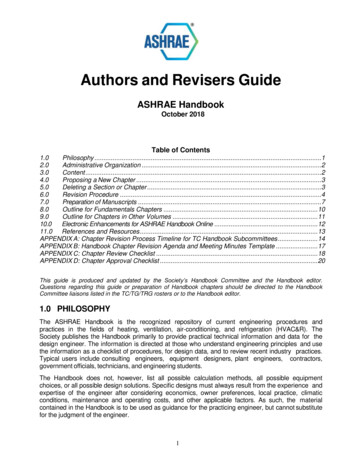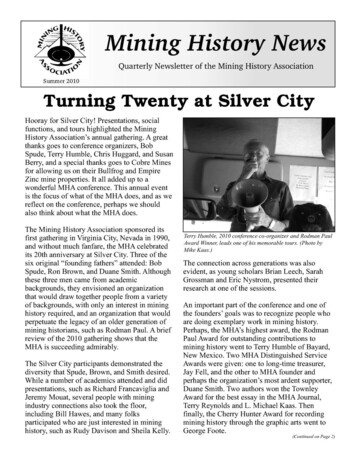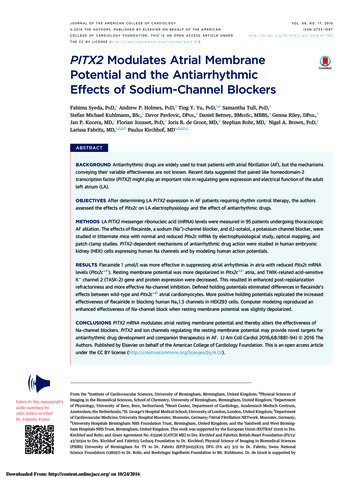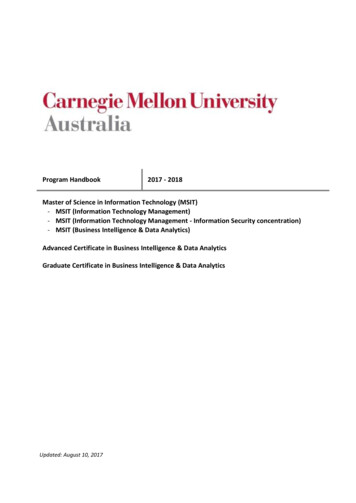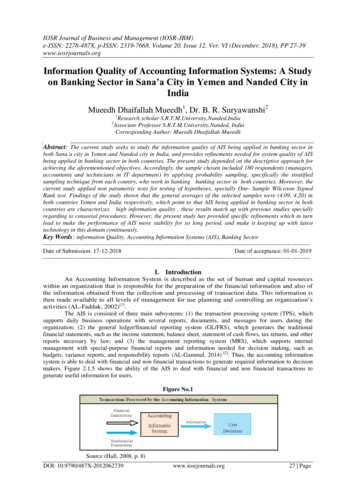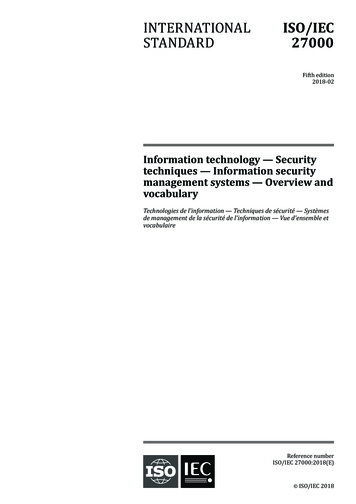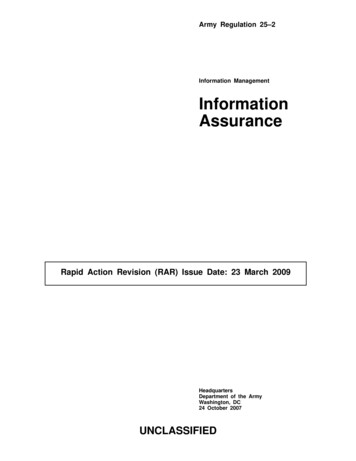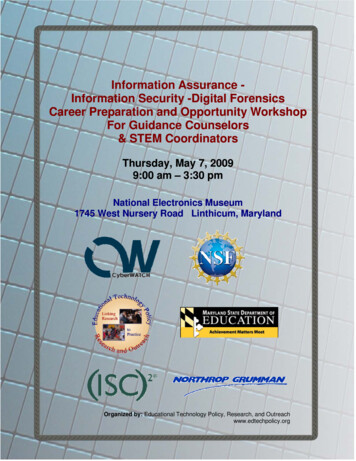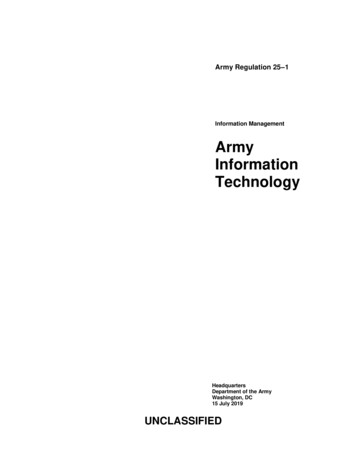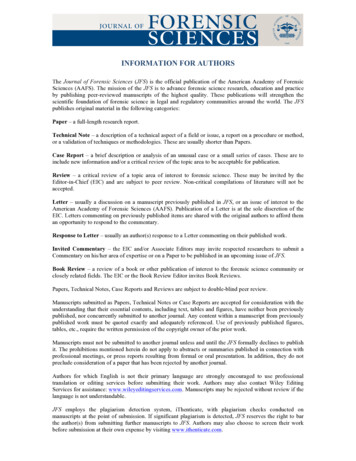
Transcription
INFORMATION FOR AUTHORSThe Journal of Forensic Sciences (JFS) is the official publication of the American Academy of ForensicSciences (AAFS). The mission of the JFS is to advance forensic science research, education and practiceby publishing peer-reviewed manuscripts of the highest quality. These publications will strengthen thescientific foundation of forensic science in legal and regulatory communities around the world. The JFSpublishes original material in the following categories:Paper – a full-length research report.Technical Note – a description of a technical aspect of a field or issue, a report on a procedure or method,or a validation of techniques or methodologies. These are usually shorter than Papers.Case Report – a brief description or analysis of an unusual case or a small series of cases. These are toinclude new information and/or a critical review of the topic area to be acceptable for publication.Review – a critical review of a topic area of interest to forensic science. These may be invited by theEditor-in-Chief (EIC) and are subject to peer review. Non-critical compilations of literature will not beaccepted.Letter – usually a discussion on a manuscript previously published in JFS, or an issue of interest to theAmerican Academy of Forensic Sciences (AAFS). Publication of a Letter is at the sole discretion of theEIC. Letters commenting on previously published items are shared with the original authors to afford theman opportunity to respond to the commentary.Response to Letter – usually an author(s) response to a Letter commenting on their published work.Invited Commentary – the EIC and/or Associate Editors may invite respected researchers to submit aCommentary on his/her area of expertise or on a Paper to be published in an upcoming issue of JFS.Book Review – a review of a book or other publication of interest to the forensic science community orclosely related fields. The EIC or the Book Review Editor invites Book Reviews.Papers, Technical Notes, Case Reports and Reviews are subject to double-blind peer review.Manuscripts submitted as Papers, Technical Notes or Case Reports are accepted for consideration with theunderstanding that their essential contents, including text, tables and figures, have neither been previouslypublished, nor concurrently submitted to another journal. Any content within a manuscript from previouslypublished work must be quoted exactly and adequately referenced. Use of previously published figures,tables, etc., require the written permission of the copyright owner of the prior work.Manuscripts must not be submitted to another journal unless and until the JFS formally declines to publishit. The prohibitions mentioned herein do not apply to abstracts or summaries published in connection withprofessional meetings, or press reports resulting from formal or oral presentation. In addition, they do notpreclude consideration of a paper that has been rejected by another journal.Authors for which English is not their primary language are strongly encouraged to use professionaltranslation or editing services before submitting their work. Authors may also contact Wiley EditingServices for assistance: www.wileyeditingservices.com. Manuscripts may be rejected without review if thelanguage is not understandable.JFS employs the plagiarism detection system, iThenticate, with plagiarism checks conducted onmanuscripts at the point of submission. If significant plagiarism is detected, JFS reserves the right to barthe author(s) from submitting further manuscripts to JFS. Authors may also choose to screen their workbefore submission at their own expense by visiting www.ithenticate.com.
Upon acceptance for publication, manuscripts become the copyright property of the AAFS. Thecorresponding author is responsible for transferring copyright to the AAFS through the Wiley AuthorLicensing Service (WALS). In doing so, the corresponding author confirms that all authors havecontributed to the manuscript per the JFS Information for Authors and all have agreed that the acceptedmanuscript will be published in JFS.Acceptance of manuscripts submitted for publication is the responsibility of the EIC and/or AssociateEditors, and occurs only after peer review of the manuscript in accordance with current AAFS Policies andProcedures. The initial review of submitted manuscripts may be expected to be completed within 21 days.The JFS EIC, Associate Editors, Managing Editor, Editorial Board Members, invited Guest Reviewers,Authors and others involved in the publication process are expected to conform to established policiesconcerning confidentiality, conflicts of interest, release of accepted manuscripts prior to actual publication,and the protection of anonymity of patients and victims.JFS requires that authors submitting manuscripts for peer review (Papers, Technical Notes, Case Reportsand Reviews) have obtained required approval(s) for submission from authorized principals and/or internalreviews in their laboratories and/or organizations.SUBMISSION OF MANUSCRIPTSJFS requirements for manuscripts are generally in accordance with the International Committee of MedicalJournal Editors (ICMJE) Recommendations for the Conduct, Reporting, Editing and Publication ofScholarly Work in Medical Journals (ICMJE Recommendations). These recommendations may be found at:http://www.icmje.org/recommendations/.The following integrates the ICMJE Recommendations as they apply to the JFS with the specificrequirements of JFS.Manuscripts must be written in English and submitted via the JFS Manuscript Central site:http://mc.manuscriptcentral.com/jofs. Figures can be saved in a neutral data format such as TIFF, PNG orEPS with a resolution of at least 300 dpi. Authors should not use PowerPoint or similar programs, or importgraphics into Word. Scanned figures should have a resolution of 300 dpi (halftone) or 600 to 1200 dpi (linedrawings) in relation to the reproduction size. Detailed information on the submission of electronic artworkcan be found at http://authorservices.wiley.com.JFS assigns manuscripts for review without identifying the authors; therefore, the title page must beuploaded as a separate file (Note: The title page should NOT be included in the manuscript file itself). Thetitle page should contain the title, a list of authors, each author’s highest academic degree(s) andaffiliation(s), any source of funding, any disclaimers, any conflicts of interest, whether the information hasbeen presented; if so, at what meeting, where and when (month/dates/year), and any acknowledgments.The manuscript file should be double-spaced and include the manuscript title, abstract, keywords, text,references, tables, and figure legends. The abstract and keywords should be on a separate page within themanuscript file, and should be identical to those included in the Manuscript Central submission site.Figures must be uploaded as separate files on the Manuscript Central site. If the tables are complex Excelfiles, they should also be uploaded as separate files. Supplemental Information should be included asseparately uploaded file(s) and designated as such with an appropriate header. Authors should reference theSupplemental Information in the manuscript.The submitted manuscript should be accompanied by a cover letter, as described below, and permissions toreproduce previously published material or to use figures that may identify human subjects. Authors shouldkeep copies of everything submitted. The EIC and/or Associate Editors reserve the right to publish themanuscript in a category different from that specified by the authors upon submission of the originalmanuscript.The cover letter should also specify, if applicable, information about possible duplicate publication,financial or other relationships that could give rise to conflicts of interest, and any other information theEIC may need to make an informed decision in accordance with established policies and practices. Copiesof any permission(s) to reproduce published material, to reproduce illustrations or report sensitive personal
information about identifiable persons, or to name persons for their contributions must accompany themanuscript.Color figures are included at no cost in the on-line version of the accepted manuscript. If the authorsbelieve color figures are necessary for the presentation of their work in the printed issue of JFS, the coverletter should indicate that the author(s) or their institutions are prepared to pay the substantial costsassociated with reproducing color figures in print. In addition, the corresponding author will need tocomplete the appropriate section of the Manuscript Central submission site.The EIC and/or Associate Editors reserve the right to request explicit, written clarification of individualauthor’s roles, their concurrence in the manuscript content, or any other issue that must be resolved prior toaccepting the manuscript for peer review.JFS does not accept submissions of manuscripts from third parties without the explicit, written permissionof the author(s).PRIOR AND DUPLICATE PUBLICATIONJFS does not consider for publication a manuscript on work that has already been reported in a publishedpaper, or that is described in a paper submitted or accepted for publication elsewhere in print or on-line.This policy does not preclude consideration of a paper that has been rejected by another journal or of acomplete report that follows publication of a preliminary report, usually in the form of an abstract. Nordoes it prevent consideration of a paper that has been presented at a scientific meeting if not published infull in proceedings or similar publication.Press reports of the meeting will not usually be considered as breaches of this rule; however, additionaldata or copies of tables and illustrations should not amplify such reports.When submitting a paper, an author should always make a full statement to the EIC about all submissionsand previous reports that might be regarded as prior or duplicate publication of the same or very similarwork. Copies of such material should be included as an appendix file with the submitted paper to help theEIC decide how to deal with the matter.Multiple publication – that is, the publication more than once of the same study, irrespective of whether thewording is the same – is rarely justified. Secondary publication in another language is one possiblejustification, providing the following conditions are met: (1) the EIC(s)/Editor(s) of both journalsconcerned are fully informed; the EIC/Editor concerned with secondary publication should have a printedor electronic copy of the primary version, (2) the priority of the primary publication is by a publicationinterval of at least two weeks, (3) the paper for secondary publication is written for a different group ofreaders and is not simply a translated version of the primary paper; an abbreviated version will often besufficient, (4) the secondary version reflects faithfully the data and interpretations of the primary version,and (5) a footnote on the title page of the secondary version informs readers, peers, and documentingagencies that the paper was edited, and is being published, for a national audience in parallel with a primaryversion based on the same data and interpretations. A suitable footnote might read as follows: "This articleis based on a study first reported in the [title of journal, with full reference]."Multiple publication other than as defined above is unacceptable. If authors violate this rule, the EICreserves the right to bar them from further submissions to JFS.PREPARATION OF MANUSCRIPTDouble-spacing should be used throughout the manuscript, including the abstract, keywords, text,references, table legends and figure legends.In addition to the information requested above, the cover letter should indicate where the work has beenpresented at professional meetings (including meeting dates and location), and should identify any sourcesof financial support and/or potential conflicts of interest.
AuthorshipAll persons designated as authors must qualify for authorship. The order of authorship should be a jointdecision of the coauthors. Each author should have participated sufficiently in the work to take publicresponsibility for the content.Authorship credit should be based only on substantial contributions to: a) conception and design or analysisand interpretation of data, b) drafting the article or revising it critically for important intellectual content,and c) final approval of the version to be published. Conditions a), b), and c) must all be met. Participationsolely in the acquisition of funding or the collection of data does not justify authorship. General supervisionof the research group is not sufficient for authorship. Any part of an article critical to its main conclusionsmust be the responsibility of at least one author.JFS may require authors to justify the assignment of authorship. Increasingly, multi-center trials or workare attributed to a corporate author. All members of the group named as authors, either in the authorshipposition below the title or in a footnote, should fully meet the criteria for authorship as defined in theICMJE Recommendations. Group members who do not meet these criteria should be listed, with theirpermission, under Acknowledgments (see Acknowledgments).Title PageJFS assigns manuscripts for review without identifying the authors; therefore, the title page must beuploaded as a separate file (Note: The title page should NOT be included in the manuscript file itself). Thetitle page should contain the manuscript’s title, a list of authors, each author’s highest academic degree(s)and affiliation(s), any source of funding, any disclaimers, any conflicts of interest, whether the informationhas been presented; if so, at what meeting, where and when (month/dates/year) and any acknowledgments.AcknowledgmentsTo facilitate the double-blind peer review process, the acknowledgments section should be included on thetitle page. Here, specify contributions that need acknowledging but do not justify authorship, such asgeneral support by a department chair or acknowledgments of technical help. Persons who have contributedintellectually to the paper but whose contributions do not justify authorship may be named and theirfunction or contribution described, for example, "scientific adviser," "critical review of study proposal,""data collection," or "participation in clinical trial." Such persons must have given their permission to benamed. The Acknowledgments header should be italicized.Authors are responsible for obtaining written permission from persons acknowledged by name, becausereaders may infer their endorsement of the data and conclusions. Technical help should be acknowledged ina paragraph separate from those acknowledging other contributions.Acknowledgments of financial support should appear as footnotes to the title of the paper on the title page.Abstract and KeywordsThe abstract should be no more than 150 words. JFS uses unstructured abstracts; however, the abstractshould include the following – background, brief description of methods and results (give specific data andtheir statistical significance, if possible), and conclusions. Emphasize new and important aspects of thestudy or observations. The word ABSTRACT should be in all capital letters and bolded.Authors should provide a minimum of six keywords that will assist indexers in cross-indexing the articleand that may be published with the abstract. The first keyword must be forensic science; the second andsubsequent keywords should assist indexers in properly categorizing the work so that it will be found injournal article databases by interested researchers. Use terms from the medical subject headings (MeSH)list of Index Medicus; if suitable MeSH terms are not yet available for recently introduced terms, presentterms may be used. Frequently, the second keyword represents a subfield of forensic science, e.g., forensicanthropology, forensic pathology, or DNA typing. In manuscripts on DNA typing, every locus involved inthe study should be listed as a separate keyword. Do not use abbreviations for keywords, e.g., polymerasechain reaction (not PCR), gas chromatography-mass spectrometry (not GCMS). The word KEYWORDSshould be in all capitals and bolded.
TextThe text of observational and experimental articles is usually – but not necessarily – divided into sectionswith headings. JFS does not use an “Introduction” heading. The introductory text begins on the first textpage. Other typical headings include Methods (or Materials and Methods), Results, and Discussion. Longarticles may need subheadings within the sections to clarify their content, especially the Results andDiscussion sections. Other types of articles, such as Case Reports, are likely to need different headings andsubheadings. Generally, avoid overuse of subheadings, especially in the Methods section. Headings shouldbe in upper and lower case and bolded, subheadings should be in upper and lower case and un-bolded anditalicized, and sub-sub-headings should be in upper and lower case and normal text (no bold or italicize).IntroductionIn JFS, the text component of the manuscript begins with an introduction; however, JFS does not use the“Introduction” heading. State the purpose of the article, and summarize the rationale for the study orobservation. Give only strictly pertinent references, and do not review referenced articles extensively orinclude data or conclusions from the work being reported.Materials and MethodsDescribe your selection of the observational or experimental subjects (patients or laboratory animals,including controls) clearly. Identify the methods, apparatus (manufacturer's name and address inparentheses), and procedures in sufficient detail to allow other workers to reproduce the results. Givereferences to established methods, including statistical methods (see below); provide references and briefdescriptions for methods that have been published but are not well known; describe new or substantiallymodified methods, give reasons for using them, and evaluate their limitations. Identify precisely all drugsand chemicals used, including generic name(s), dose(s), and route(s) of administration. Generally avoid theoveruse of subheadings in the Methods section. Describe the methods and materials in narrative style, notin the style of a laboratory procedure handout.Responsible Reporting of Research Involving Human and/or Animal SubjectsGuidelines available l%20standards authors for%20website 11 Nov 2011.pdfAppropriate approval, licensing or registration should be obtained before the research begins and detailsshould be provided in the manuscript (e.g., Institutional Review Board, Research Ethics Committeeapproval, national licensing authorities for the use of animals).If requested by the EIC, authors should supply evidence that the reported research received the appropriateapproval and was carried out ethically (e.g., copies of approvals, licenses, participant consent forms).Researchers should not generally publish or share identifiable individual data collected in the course ofresearch without specific consent from the individual (or their representative). Researchers shouldremember that many scholarly journals are now freely available on the Internet, and should therefore bemindful of the risk of causing danger or upset to unintended readers.StatisticsDescribe statistical methods with enough detail to enable a knowledgeable reader with access to theoriginal data to verify the reported results. When possible, quantify findings and present them withappropriate indicators of measurement error or uncertainty (such as confidence intervals).Avoid sole reliance on statistical hypothesis testing, such as the use of P values, which fails to conveyimportant quantitative infor
The manuscript file should be double-spaced and include the manuscript title, abstract, keywords, text, references, tables, and figure legends. The abstract and keywords should be on a separate page within the manuscript file, and should be identical to those included in
